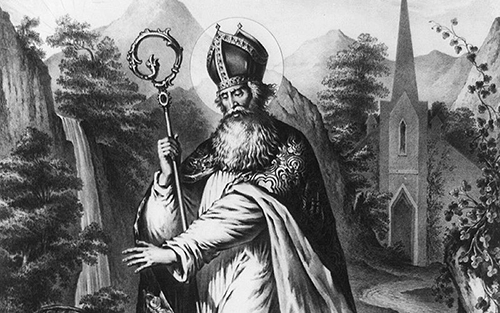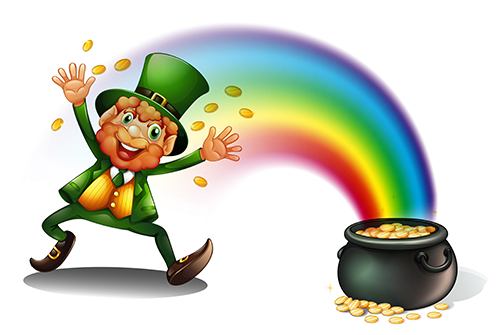St Patrick’s Day is one of the world’s most popular celebrations of Irish culture. Outside Ireland itself, the festivities are most prominent in the United States, Canada, and Australia, but it is currently recognized in more than 200 countries around the globe. Although March 17th marks the anniversary of St Patrick’s death, it also commemorates his life.
#TeamABM celebrates the occasion by delving into the surprising history and time-honoured traditions that make the day unique.
Emerald Isle, Verdant Gem of Western Europe

The story of St Patrick is inseparably linked to the history of Ireland. Ireland is an island nation in the North Atlantic Ocean that exists as part of the British Isles. Although it shares a single landmass, geopolitically it is divided into two components. The larger of the two is the Republic of Ireland, a sovereign country officially recognized with Dominion status in 1922 after separating from the United Kingdom. The northeastern portion of the island is known as Northern Ireland, and still exists as part of the United Kingdom.
Ireland’s lush landscapes and rolling green hills have earned it the nickname “Emerald Isle”. The mild climate and heavy rainfall provide ideal conditions for rich vegetation growth. Throughout its history, agriculture has remained a significant industry. Roughly, two-thirds of Ireland is currently devoted to farming and livestock rearing.
Irish tradition is a rich tapestry with a heavy focus on music and dance. Some of their most famously enduring folklore includes banshees, fairies, and of course leprechauns. In terms of religion, Ireland is predominantly Roman Catholic – which of course leads back to the world-famous St Patrick…
St Patrick, Patron Saint of Ireland

Knowledge is a wonderful thing, but even in today’s age of information, there is abundant confusion between facts and assumptions based on popular belief. St Patrick is an excellent example of that. What is considered general knowledge about St Patrick’s Day?
Most people would agree on the following summary: The celebration of St Patrick’s Day involves copious use of the color green in celebration of an Irish saint named Patrick who drove all the snakes out of Ireland. Shockingly, none of that is historically accurate.
Records from the period are inconclusive, but evidence suggests that St Patrick was born around 386 A.D., and died around 461 A.D. on March 17th. Contrary to popular belief though, he was not born in Ireland. His actual birthplace was Roman Britain. When he was 16 years old Patrick was captured and enslaved by Irish pirates.
After years of servitude tending sheep, he escaped to France where he reunited with his family and joined the Catholic Church. Once ordained as a bishop in 432 A.D., he returned to Ireland to conduct missionary work.
One of the most famous legends of St Patrick was that he banished all the snakes from Ireland, driving them into the sea. That account is highly unlikely, however, as recent evidence suggests that snakes never inhabited the island in the first place.
Although he is referred to as a saint, St Patrick was never officially canonized by the Catholic church. In fact, his real name wasn’t even Patrick. Born as Maewyn Succat, he later took on the name Patrick during his religious journeys.
Green may be the official color we associate with St Patrick’s Day, but St Patrick himself most commonly wore blue. Even the Order of St Patrick created by King George III in 1783 used celestial blue as its official color.
Irish Symbolism and Tradition

Gross historical inaccuracies aside, the spirit of St Patrick’s Day is a boisterous celebration of Irish culture. What are the best ways to immerse yourself in the festivities? Here is a quick cheat sheet of iconic Irish symbolism and heritage:
Shamrocks: Commonly regarded as a symbol of luck. In Irish culture, it also symbolized the rebirth of spring, and around the seventeenth century, it became a symbol of Irish nationalism. St Patrick famously used the shamrock to demonstrate the Christian Holy Trinity, showing how three individual elements could be part of the same whole.
Leprechauns: Don’t let the lovable Lucky Charms mascot fool you. In addition to greedily hoarding pots of gold at the end of rainbows, these wee folk have a nasty habit of randomly pinching people.
Green: While the color doesn’t represent St Patrick himself, it is strongly associated with Ireland. In addition to being fashionable, the most important benefit of wearing green on St Patrick’s Day is to make you invisible to Leprechauns.
Music: Since the days of the ancient Celts, folk music has always been a vital part of Irish life. As an oral culture, most Irish history and tradition is passed from one generation to the next by way of stories and songs. Harps are particularly popular instruments.
Dance: Traditional dances are equally important in Irish culture. Their most famous dance styles include Step, Jig, Céilí, and Irish Tap.
Food: Corned beef and cabbage or bangers and mash are the usual staples, but traditional Irish bacon is also a common option. Alcoholic beverages are quite popular as well, particularly green ones. Last year Guinness reported 13 million pints of their beer were served on St Paddy’s Day – that’s an 819% increase over any other day of the year.
Frequently Asked Questions

When was the first St Patrick’s Day?
- St Patrick’s Day was first celebrated in Ireland as a feast day in the ninth or tenth century. The first official parade was actually held in America in 1601 in a Spanish colony that became St Augustine, Florida.
What is the difference between Shamrocks and Clovers?
- While the terms are often used interchangeably, a shamrock is specifically a clover with three leaves. Most clovers are of the three-leaf variety, thus four-leaf clovers are considered extra lucky due to their rarity.
Final Thoughts
Happy St Paddy’s Day from all of us at ABM College! Don your greenest garb. Raise a pint of green ale. Shake your shamrocks. Savor a bowl of magically delicious lucky charms. However you choose to celebrate, we hope that you have a fantastic day and may the “Luck o’ the Irish” be with ye!
Just remember that when it comes to your career opportunities, you shouldn’t leave your future to luck. Check into our employment-driven diploma programs to find the one that fits you best.
Contact us now to learn more about ABM College.
You can also read more industry-relevant blogs here.
For the sake of completeness, March 17th is also World Sleep Day. For anyone who rather stay in bed on Friday, that is a perfectly valid and internationally approved life choice.
About The Author

Content Editor & Writer, ABM College
As Content Editor at ABM College in Calgary, Alberta, Stephen plays a key role in advancing the college’s mission to provide relevant, high-quality training for today’s job market. He ensures all blog articles and web materials are accurate, clear, and genuinely useful for students, career changers, and industry professionals.
Stephen is also the author of a best-selling historical reference series documenting decades of computer and video gaming history — a body of work recognized by the Canadian Choice Awards.
Connect with Stephen on LinkedIn, explore his published works at Falcon Designs, or see his editorial expertise in action on the ABM College Blog.
